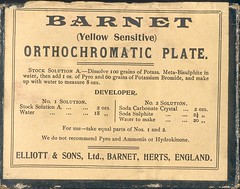Difference between revisions of "Orthochromatic"
m (spelling) |
Hanskerensky (talk | contribs) (Corrected small typ-o "as they does" to "as they do" in the second paragraph) |
||
| (12 intermediate revisions by 5 users not shown) | |||
| Line 1: | Line 1: | ||
| − | ''' | + | {{glossary}} |
| + | An '''orthochromatic''' ("correct colors") photographic emulsion is a black & white film emulsion, sensitive to wider range of colors than the earliest color-blind (blue sensitive) types based on unmodified silver halides. This name was used for the very first time in 1884, for dry photographic plates sensitized with Erythrosin. | ||
| − | Orthochromatic | + | Orthochromatic emulsions still have high sensitivity to blue, generally correct sensitivity to green and bright yellow, but low sensitivity to orange and are practically insensitive to red, as they do not register wavelengths longer than approximately 560-600 nm (medium yellow to orange). Furthermore, orthochromatic emulsions have decreased sensitivity in the 500 nm area (pale blue), as compared to color-blind emulsions, and so they reproduce blue colors more accurately. |
| − | The next step in development of color sensitivity was [[panchromatic]] | + | Orthochromatic emulsions with equalized sensitivity to green and yellow were sometimes called '''isoorthochromatic''' emulsion, while typical orthochromatic emulsions had insufficient sensitivity to green as compared to yellow. |
| + | |||
| + | The next step in the development of color sensitivity was [[isochromatic]] and [[panchromatic]] emulsions. | ||
| + | |||
| + | |||
| + | {{Flickr_image | ||
| + | |image_source= http://www.flickr.com/photos/34370769@N07/5410526447/in/pool-camerawiki/ | ||
| + | |image= http://farm6.staticflickr.com/5096/5410526447_6fc9c96059_m.jpg | ||
| + | |image_align= center | ||
| + | |image_text= Barnet Orthochromatic Plate Box | ||
| + | |image_by= John Rochon | ||
| + | |image_rights= with permission | ||
| + | }} | ||
| + | == Sources == | ||
| + | * Kleffe H.: Aus der Geschichte der Fototechnik; VEB Fotokinoverlag Leipzig, Leipzig, 1983. | ||
| + | * Puskow V.V.: Poradnik fotograficzny [Photographic handbook]; PWT, Warszawa, 1956. | ||
| + | * Sommer S., Dederko W.: Vademecum fotografa [Photographer's vademecum]; FAW, Warszawa, 1956. | ||
| + | * Бунимович Д.З., Фомин А.В.: Справочник фотогафа; Легкая Индустря, Москва, 1970. | ||
| + | |||
| + | [[Category:Film]] | ||
Latest revision as of 19:14, 29 September 2012
An orthochromatic ("correct colors") photographic emulsion is a black & white film emulsion, sensitive to wider range of colors than the earliest color-blind (blue sensitive) types based on unmodified silver halides. This name was used for the very first time in 1884, for dry photographic plates sensitized with Erythrosin.
Orthochromatic emulsions still have high sensitivity to blue, generally correct sensitivity to green and bright yellow, but low sensitivity to orange and are practically insensitive to red, as they do not register wavelengths longer than approximately 560-600 nm (medium yellow to orange). Furthermore, orthochromatic emulsions have decreased sensitivity in the 500 nm area (pale blue), as compared to color-blind emulsions, and so they reproduce blue colors more accurately.
Orthochromatic emulsions with equalized sensitivity to green and yellow were sometimes called isoorthochromatic emulsion, while typical orthochromatic emulsions had insufficient sensitivity to green as compared to yellow.
The next step in the development of color sensitivity was isochromatic and panchromatic emulsions.

|
| Barnet Orthochromatic Plate Box image by John Rochon (Image rights) |
Sources
- Kleffe H.: Aus der Geschichte der Fototechnik; VEB Fotokinoverlag Leipzig, Leipzig, 1983.
- Puskow V.V.: Poradnik fotograficzny [Photographic handbook]; PWT, Warszawa, 1956.
- Sommer S., Dederko W.: Vademecum fotografa [Photographer's vademecum]; FAW, Warszawa, 1956.
- Бунимович Д.З., Фомин А.В.: Справочник фотогафа; Легкая Индустря, Москва, 1970.